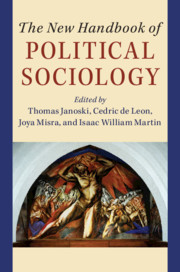Book contents
- The New Handbook of Political Sociology
- The New Handbook of Political Sociology
- Copyright page
- Dedication
- Contents
- Tables
- Figures
- Contributors
- Acknowledgments
- Introduction
- I Theories of Political Sociology
- II Media Explosion, Knowledge as Power, and Demographic Reversals
- III The State and Its Political Organizations
- IV Civil Society: The Roots and Processes of Political Action
- 22 The Challenges of Citizenship in Civil Society
- 23 Social Movements
- 24 Political Parties
- 25 Machine Politics and Clientelism
- 26 The Good, the Bland, and the Ugly
- 27 The Politics of Economic Crisis
- 28 The Influence of Public Opinion and Advocacy on Public Policy
- 29 Nationalism
- V Established and New State Policies and Innovations
- VI Globalization and New and Bigger Sources of Power and Resistance
- Index
- References
26 - The Good, the Bland, and the Ugly
Volunteering, Civic Associations, and Participation in Politics
from IV - Civil Society: The Roots and Processes of Political Action
Published online by Cambridge University Press: 22 February 2020
- The New Handbook of Political Sociology
- The New Handbook of Political Sociology
- Copyright page
- Dedication
- Contents
- Tables
- Figures
- Contributors
- Acknowledgments
- Introduction
- I Theories of Political Sociology
- II Media Explosion, Knowledge as Power, and Demographic Reversals
- III The State and Its Political Organizations
- IV Civil Society: The Roots and Processes of Political Action
- 22 The Challenges of Citizenship in Civil Society
- 23 Social Movements
- 24 Political Parties
- 25 Machine Politics and Clientelism
- 26 The Good, the Bland, and the Ugly
- 27 The Politics of Economic Crisis
- 28 The Influence of Public Opinion and Advocacy on Public Policy
- 29 Nationalism
- V Established and New State Policies and Innovations
- VI Globalization and New and Bigger Sources of Power and Resistance
- Index
- References
Summary
The value of volunteering and associational groups for social political life has long interested scholars studying modern democratic societies. Since Alexis de Tocqueville published his seminal work on Democracy in America in the 1830s (2001), much focus has been on the good that volunteering in civic associations does for fostering pro-social behavior and for building public participatory processes in democratic governments. A more recent and critical view asserts that the work of civic associations can also be socially corrosive, paternalistic, intolerant of outsiders, geared toward corporate self-interest, and actively antidemocratic. In addition, much volunteering in civic groups is shallow, menial, apolitical social activity that holds little, if any, transformative social potential.
- Type
- Chapter
- Information
- The New Handbook of Political Sociology , pp. 681 - 714Publisher: Cambridge University PressPrint publication year: 2020

